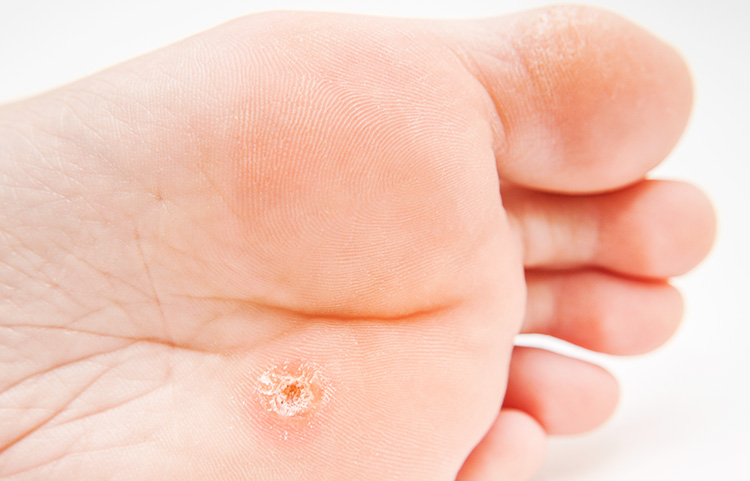What are warts and verrucas?
Warts are small and usually grainy skin growths that often feel rough to the touch and can range in colour and appearance according to the location on the skin. Most often, warts appear on your feet, hands and fingers, although they can grow on other parts of the body as well.
Verrucas, or plantar warts, are warts that grow exclusively on the soles of your feet.
What do warts look like?
Warts first appear as an extra layer of hard skin, resulting in a raised growth that looks like a tiny cauliflower and usually has a rough surface. The colour of warts can range from white to brown-grey.

Types of warts
There are four types of warts:
- Common warts (Verruca vulgaris) – the most common type of wart, they can appear individually or in groups anywhere on your body but are most commonly seen on hands and feet. Common warts look like raised growths on the skin and have a hard, uneven surface area.
- Plantar warts (Verruca plana, also known as verrucas) – these are warts on the soles of the feet that have been pushed into the skin surface by the weight of the body. They often grow in clusters.
- Plane warts (Verruca pedis) – these are smaller warts that lie flatter on the skin. They usually appear on the hands or face.
- Subungual and periungual warts – these are rough, irregular warts that form underneath the toenails and fingernails. They start out small but can grow to the size of a pea and cause the nail to become loose and deformed.
What causes warts?
Warts are caused by the human papillomavirus (HPV), which infects the cells in the outer layer of the skin through dry and cracked skin, or a cut or scratch. There are over 100 different types of HPV viruses, and they are contagious with a long incubation period (anywhere between two and six months) which can make it difficult to identify where you came into contact with a wart virus.
The viruses that cause warts are usually completely harmless, and not everybody who comes into contact with wart viruses becomes infected. The reasons for this are not completely understood, but your genetic makeup and immune system are likely involved. A family history of warts could make you more susceptible to wart viruses, and people who have a weakened immune system are also at higher risk. Children, whose immune systems are not fully developed, are also more susceptible to wart viruses than healthy adults.
Once you have become infected, the wart virus initially lies dormant and the infection only becomes apparent after the wart starts to grow.
Warts can also spread from one place on your body to another. Fingertips are especially vulnerable and the area around the nail may become infected from activates such as nail biting.
There are two main ways of contacting warts:
- Direct contact – Warts are most commonly spread from one person to another when broken skin comes into direct contact with a wart, for example through a handshake. Warts can also spread from one place on your body to another through contact with broken skin, such as on fingertips and the area around nails from nail biting and picking at a wart.
- Indirect contact – Warts can also be passed on via objects that carry infected skin cells that have peeled off from the wart, such as sharing towels with people who have warts or walking barefoot in places like locker rooms and public showers. This means spreading warts between different family members in your own home is likely.1
Preventing the spread of warts can be difficult since the viruses that cause warts are everywhere – an estimated 10 percent of the population is infected.2 If you have warts, you can avoid infecting other people by treating your warts
How to avoid warts and verrucas
Avoiding and preventing the spread of warts and verrucas can be difficult. Find out more about wart and verruca prevention.
Wart and verruca preventionHow to remove warts and verrucas
There are a number of different methods for removing warts and verrucas. Find out more about wart and verruca treatments.
Wart and verruca treatmentWart and verruca FAQs
Want to know more about warts and verrucas? Read our frequently asked questions.
What are warts and verrucas?
EndWarts® PEN
EndWarts® PEN is an effective wart treatment that takes only seconds to apply. The solution can be used by the whole family to remove warts and verrucas on hands and feet*. For children under 4 a HCP should be consulted.
Find out more
EndWarts® FREEZE
EndWarts® FREEZE is our latest alternative to EndWarts® PEN that uses rapid freeze technology (otherwise known as cryotherapy) to effectively remove warts and verrucas from hands and feet.
Find out moreWarts in children
It is estimated that one in three children in the age range 4-12 have warts or verrucas, especially those that attend nurseries and schools.1 Although harmless, they can be unsightly and sometimes uncomfortable, causing embarrassment in social situations for older children and adolescents.
Children are more prone to becoming infected with HPV because their immune systems are not fully developed, and they also tend to have more cuts and scrapes than adults. Consequently, countries, where nurseries are more common, have a higher rate of warts in children.
If you see signs of warts on children, they should be treated immediately, as it can take two years or more for warts to disappear on their own and the infection could spread to others in the meantime
References
- 1. Van Haalen, et al. British Journal of Dermatology 2009; 161: 148-152.
- 2. Weber C,A. Podiatry Today. 2013;26:68-73
UK-END-2024-00014 September 2024


